

Compact Muon Solenoid
LHC, CERN
| CMS-FSQ-16-005 ; CERN-EP-2017-310 | ||
| Constraints on the double-parton scattering cross section from same-sign W boson pair production in proton-proton collisions at $ \sqrt{s} = $ 8 TeV | ||
| CMS Collaboration | ||
| 6 December 2017 | ||
| JHEP 02 (2018) 032 | ||
| Abstract: A first search for same-sign WW production via double-parton scattering is performed based on proton-proton collision data at a center-of-mass energy of 8 TeV using dimuon and electron-muon final states. The search is based on the analysis of data corresponding to an integrated luminosity of 19.7 fb$^{-1}$. No significant excess of events is observed above the expected single-parton scattering yields. A 95% confidence level upper limit of 0.32 pb is set on the inclusive cross section for same-sign WW production via the double-parton scattering process. This upper limit is used to place a 95% confidence level lower limit of 12.2 mb on the effective double-parton cross section parameter, closely related to the transverse distribution of partons in the proton. This limit on the effective cross section is consistent with previous measurements as well as with Monte Carlo event generator predictions. | ||
| Links: e-print arXiv:1712.02280 [hep-ex] (PDF) ; CDS record ; inSPIRE record ; HepData record ; CADI line (restricted) ; | ||
| Figures | |

png pdf |
Figure 1:
Schematic diagrams corresponding to the production of a same-sign W boson pair via the DPS process (left) and via SPS processes (right). |

png pdf |
Figure 1-a:
Schematic diagram corresponding to the production of a same-sign W boson pair via the DPS process. |

png pdf |
Figure 1-b:
Schematic diagrams corresponding to the production of a same-sign W boson pair via SPS processes. |

png pdf |
Figure 2:
Distributions of the $p_{\mathrm {T}_{2}}$ (top-left), $m_\mathrm {T}(\mu _{2} , {{p_{\mathrm {T}}} ^\text {miss}})$ (top-right), $\Delta \phi (\vec{p}_{\mathrm {T}_{1}}, \vec{p}_{\mathrm {T}_{2}})$ (bottom-left), and $\Delta \phi (\vec{p}_{\mathrm {T}_{2}}, {\vec{p}_{\mathrm {T}}^{\text {miss}}})$ (bottom-right) variables for the dimuon channel, after the same-sign WW selection criteria have been applied. The data are represented by the black dots and the shaded histograms represent the predicted signal and background processes normalized according to the estimated cross sections and the luminosity. For each individual distribution, the bottom panels show the ratio of the number of events observed in the data to that predicted by the simulation, along with the associated statistical uncertainty. The hatched bands in all cases represent the sum of the systematic and statistical uncertainties of the simulated samples, added in quadrature. |
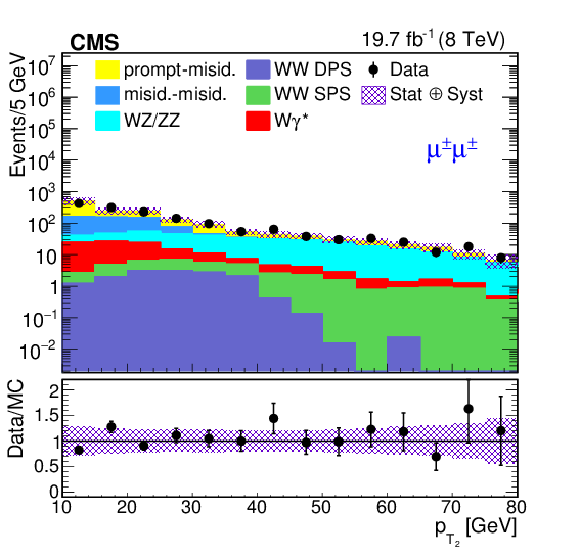
png pdf |
Figure 2-a:
Distribution of the $p_{\mathrm {T}_{2}}$ variable for the dimuon channel, after the same-sign WW selection criteria have been applied. The data are represented by the black dots and the shaded histograms represent the predicted signal and background processes normalized according to the estimated cross sections and the luminosity. The bottom panel shows the ratio of the number of events observed in the data to that predicted by the simulation, along with the associated statistical uncertainty. The hatched bands in all cases represent the sum of the systematic and statistical uncertainties of the simulated samples, added in quadrature. |

png pdf |
Figure 2-b:
Distribution of the $m_\mathrm {T}(\mu _{2} , {{p_{\mathrm {T}}} ^\text {miss}})$ variable for the dimuon channel, after the same-sign WW selection criteria have been applied. The data are represented by the black dots and the shaded histograms represent the predicted signal and background processes normalized according to the estimated cross sections and the luminosity. The bottom panel shows the ratio of the number of events observed in the data to that predicted by the simulation, along with the associated statistical uncertainty. The hatched bands in all cases represent the sum of the systematic and statistical uncertainties of the simulated samples, added in quadrature. |

png pdf |
Figure 2-c:
Distribution of the $\Delta \phi (\vec{p}_{\mathrm {T}_{1}}, \vec{p}_{\mathrm {T}_{2}})$ variable for the dimuon channel, after the same-sign WW selection criteria have been applied. The data are represented by the black dots and the shaded histograms represent the predicted signal and background processes normalized according to the estimated cross sections and the luminosity. The bottom panel shows the ratio of the number of events observed in the data to that predicted by the simulation, along with the associated statistical uncertainty. The hatched bands in all cases represent the sum of the systematic and statistical uncertainties of the simulated samples, added in quadrature. |
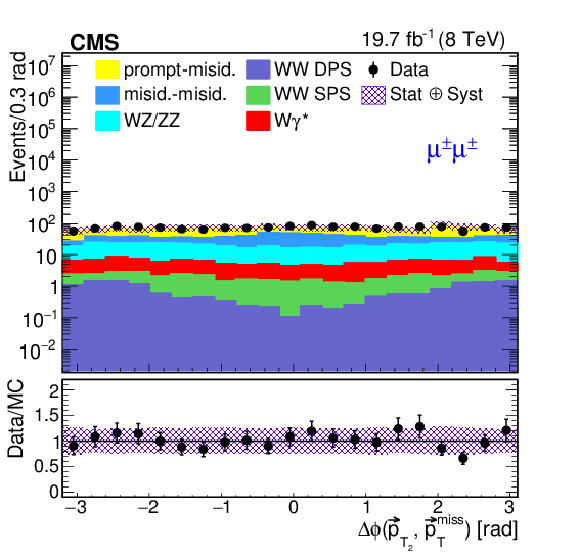
png pdf |
Figure 2-d:
Distribution of the $\Delta \phi (\vec{p}_{\mathrm {T}_{2}}, {\vec{p}_{\mathrm {T}}^{\text {miss}}})$ variable for the dimuon channel, after the same-sign WW selection criteria have been applied. The data are represented by the black dots and the shaded histograms represent the predicted signal and background processes normalized according to the estimated cross sections and the luminosity. The bottom panel shows the ratio of the number of events observed in the data to that predicted by the simulation, along with the associated statistical uncertainty. The hatched bands in all cases represent the sum of the systematic and statistical uncertainties of the simulated samples, added in quadrature. |
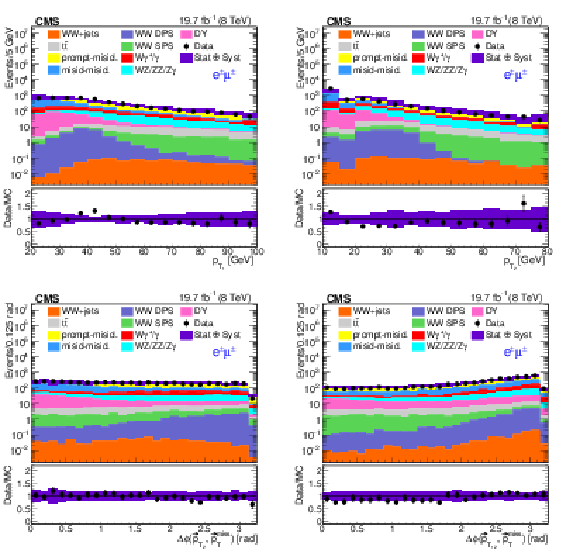
png pdf |
Figure 3:
Distributions of the $p_{\mathrm {T}_{1}}$ (top-left), $p_{\mathrm {T}_{2}}$ (top-right), $\Delta \phi (\vec{p}_{\mathrm {T}_{2}}, {\vec{p}_{\mathrm {T}}^{\text {miss}}})$ (bottom-left), and $\Delta \phi (\vec{p}_{\mathrm {T}_{12}}, {\vec{p}_{\mathrm {T}}^{\text {miss}}})$ (bottom-right) variables for the electron-muon channel, after the same-sign WW selection criteria have been applied. Symbols and patterns are the same as in Fig. 2. |
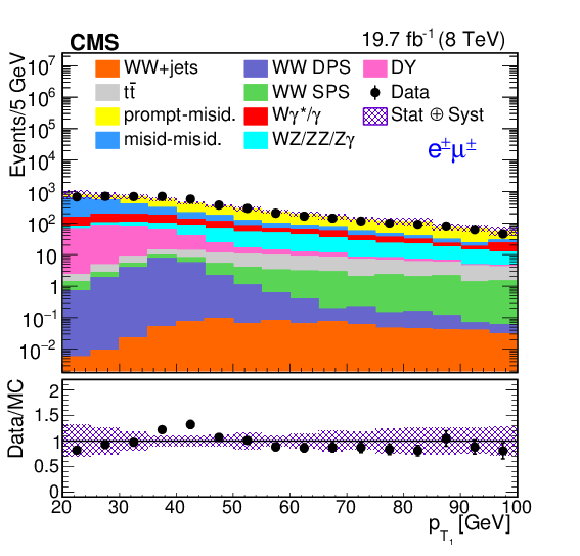
png pdf |
Figure 3-a:
Distribution of the $p_{\mathrm {T}_{1}}$ variable for the electron-muon channel, after the same-sign WW selection criteria have been applied. Symbols and patterns are the same as in Fig. 2. |

png pdf |
Figure 3-b:
Distribution of the $p_{\mathrm {T}_{2}}$ variable for the electron-muon channel, after the same-sign WW selection criteria have been applied. Symbols and patterns are the same as in Fig. 2. |

png pdf |
Figure 3-c:
Distribution of the $\Delta \phi (\vec{p}_{\mathrm {T}_{2}}, {\vec{p}_{\mathrm {T}}^{\text {miss}}})$ variable for the electron-muon channel, after the same-sign WW selection criteria have been applied. Symbols and patterns are the same as in Fig. 2. |

png pdf |
Figure 3-d:
Distribution of the $\Delta \phi (\vec{p}_{\mathrm {T}_{12}}, {\vec{p}_{\mathrm {T}}^{\text {miss}}})$ variable for the electron-muon channel, after the same-sign WW selection criteria have been applied. Symbols and patterns are the same as in Fig. 2. |
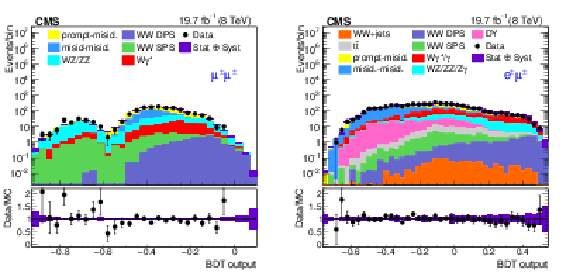
png pdf |
Figure 4:
Distribution of the BDT discriminant, for the dimuon channel (left) and for the electron-muon channel (right). The data are represented by the black dots and the shaded histograms represent the pre-fit signal and post-fit background processes. The bottom panels show the ratio of data to the sum of all signal and background contributions. The hatched bands represent the post-fit uncertainty, which includes both the statistical and systematic components. |
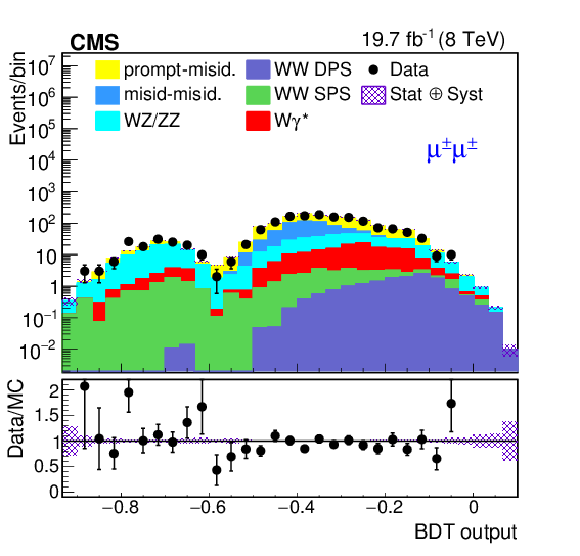
png pdf |
Figure 4-a:
Distribution of the BDT discriminant, for the dimuon channel. The data are represented by the black dots and the shaded histograms represent the pre-fit signal and post-fit background processes. The bottom panel shows the ratio of data to the sum of all signal and background contributions. The hatched bands represent the post-fit uncertainty, which includes both the statistical and systematic components. |

png pdf |
Figure 4-b:
Distribution of the BDT discriminant, for the electron-muon channel. The data are represented by the black dots and the shaded histograms represent the pre-fit signal and post-fit background processes. The bottom panel shows the ratio of data to the sum of all signal and background contributions. The hatched bands represent the post-fit uncertainty, which includes both the statistical and systematic components. |
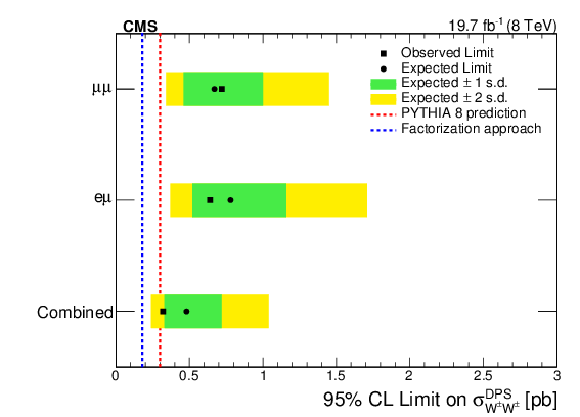
png pdf |
Figure 5:
Expected and observed 95% CL upper limits on the same-sign $\sigma ^\mathrm {DPS}_{\mathrm{W} ^{\pm}\mathrm{W} ^{\pm}}$ for the dimuon and electron-muon final states, along with their combination. The predicted values of $\sigma ^\mathrm {DPS}_{\mathrm{W} ^{\pm}\mathrm{W} ^{\pm}}$ from PYTHIA 8 and from the factorization approach [21] are also shown. |
| Tables | |

png pdf |
Table 1:
Event selection criteria for same-sign W boson pair production in dimuon and electron-muon channels. |

png pdf |
Table 2:
Control regions enriched with misidentified leptons used to extract the lepton misidentification rate. Region 1 is used for the dimuon channel. Region 2, with the additional requirement of least one b-tagged jet, is used in the electron-muon channel to reduce semileptonically decaying $ {\mathrm{t} {}\mathrm{\bar{t}}} $ events. |

png pdf |
Table 3:
Expected and observed 95% CL limits on the cross section for inclusive same-sign WW production via DPS for the dimuon and electron-muon channels along with their combination. |
| Summary |
| A first search for same-sign W boson pair production via double-parton scattering (DPS) in pp collisions at a center-of-mass energy of 8 TeV has been presented. The analyzed data were collected by the CMS detector at the LHC during 2012 and correspond to an integrated luminosity of 19.7 fb$^{-1}$. The results presented here are based on the analysis of events containing two same-sign W bosons decaying into either same-sign muon-muon or electron-muon pairs. Several kinematic observables have been studied to identify those that can better discriminate between DPS and the single-parton scattering (SPS) backgrounds. These observables with discriminating power are used as an input to a multivariate analysis based on boosted decision trees. No excess over the expected contributions from SPS processes is observed. A 95% confidence level (CL) upper limit of 0.32 pb is placed on the inclusive cross section for same-sign WW production via DPS. A corresponding 95% CL lower limit of 12.2 mb on the effective double-parton cross section is also derived, compatible with previous measurements as well as with Monte Carlo event generator expectations. |
| References | ||||
| 1 | T. Sjostrand and M. Van Zijl | A multiple interaction model for the event structure in hadron collisions | PRD 36 (1987) 2019 | |
| 2 | D. d'Enterria and A. Snigirev | Double, triple, and $ n $-parton scatterings in high-energy proton and nuclear collisions | 1708.07519 | |
| 3 | J. R. Gaunt, C.-H. Kom, A. Kulesza, and W. J. Stirling | Same-sign W pair production as a probe of double-parton scattering at the LHC | EPJC 69 (2010) 53 | 1003.3953 |
| 4 | G. Calucci and D. Treleani | Disentangling correlations in multiple parton interactions | PRD 83 (2011) 016012 | 1009.5881 |
| 5 | M. Rinaldi, S. Scopetta, M. Traini, and V. Vento | Double parton correlations and constituent quark models: a Light Front approach to the valence sector | JHEP 12 (2014) 028 | 1409.1500 |
| 6 | M. Diehl, D. Ostermeier, and A. Schafer | Elements of a theory for multiparton interactions in QCD | JHEP 03 (2012) 89 | 1111.0910 |
| 7 | F. A. Ceccopieri, M. Rinaldi, and S. Scopetta | Parton correlations in same-sign $ \mathrm{W} $ pair production via double parton scattering at the LHC | PRD 95 (2017) 114030 | 1702.05363 |
| 8 | M. Y. Hussein | A double parton scattering background to associate $ \mathrm{W}\mathrm{H} $ and $ \mathrm{Z}\mathrm{H} $ production at the LHC | NPPS 174 (2007) 55 | hep-ph/0610207 |
| 9 | D. Bandurin, G. Golovanov, and N. Skachkov | Double parton interactions as a background to associated HW production at the Tevatron | JHEP 04 (2011) 054 | 1011.2186 |
| 10 | M. Mekhfi | Multiparton processes: an application to double Drell--Yan | PRD 32 (1985) 2371 | |
| 11 | R. M. Godbole, S. Gupta, and J. Lindfors | Double parton scattering contribution to W + Jets | Z. Phys. C 47 (1990) 69 | |
| 12 | R. Kumar, M. Bansal, S. Bansal, and J. B. Singh | New observables for multiple-parton interactions measurements using $ \mathrm{Z} $+jets processes at the LHC | PRD 93 (2016) 054019 | 1602.05392 |
| 13 | B. Humpert and R. Odorico | Multiparton scattering and QCD radiation as sources of four jet events | PLB 154 (1985) 211 | |
| 14 | L. Ametller, N. Paver, and D. Treleani | Possible signature of multiple parton interactions in collider four jet events | PLB 169 (1986) 289 | |
| 15 | UA2 Collaboration | A study of multi-jet events at the CERN $ \bar{{\mathrm{p}}}{\mathrm{p}} $ collider and a search for double parton scattering | PLB 268 (1991) 145 | |
| 16 | Axial Field Spectrometer Collaboration | Double parton scattering in $ pp $ collisions at $ \sqrt{s} = $ 63 GeV | Z. Phys. C 34 (1987) 163 | |
| 17 | CDF Collaboration | Study of four jet events and evidence for double parton interactions in $ \bar{{\mathrm{p}}}{\mathrm{p}} $ collisions at $ \sqrt{s} = $ 1.8 TeV | PRD 47 (1993) 4857 | |
| 18 | CDF Collaboration | Double parton scattering in $ \bar{{\mathrm{p}}}{\mathrm{p}} $ collisions at $ \sqrt{s} = $ 1.8 TeV | PRD 56 (1997) 3811 | |
| 19 | D0 Collaboration | Double parton interactions in $ \gamma $+3 jet events $ \bar{{\mathrm{p}}}{\mathrm{p}} $ collisions at $ \sqrt{s} = $ 1.96 TeV | PRD 81 (2010) 052012 | hep-ex/0912.5104 |
| 20 | ATLAS Collaboration | Measurement of hard double-parton interactions in $ \mathrm{W} (\to \ell\mathrm{g}n) $ + 2-jet events at $ \sqrt{s} = $ 7 TeV with the ATLAS detector | New J. Phys. 15 (2013) 033038 | 1301.6872 |
| 21 | CMS Collaboration | Study of double parton scattering using $ \mathrm{W} $ + 2-jet events in proton-proton collisions at $ \sqrt{s} = $ 7 TeV | JHEP 03 (2014) 032 | CMS-FSQ-12-028 1312.5729 |
| 22 | M. Bahr, M. Myska, M. H. Seymour, and A. Siodmok | Extracting $ \sigma_{\rm eff} $ from the CDF $ \gamma $ + 3 jets measurement | JHEP 03 (2013) 129 | 1302.4325 |
| 23 | A. Del Fabbro and D. Treleani | Scale factor in double parton collisions and parton densities in transverse space | PRD 63 (2001) 057901 | hep-ph/0005273 |
| 24 | D. Treleani | Double parton scattering, diffraction and effective cross section | PRD 76 (2007) 076006 | 0708.2603 |
| 25 | CMS Collaboration | Event generator tunes obtained from underlying event and multiparton scattering measurements | EPJC 76 (2016) 155 | CMS-GEN-14-001 1512.00815 |
| 26 | CMS Collaboration | The CMS trigger system | JINST 12 (2017) P01020 | CMS-TRG-12-001 1609.02366 |
| 27 | CMS Collaboration | The CMS experiment at the CERN LHC | JINST 3 (2008) S08004 | CMS-00-001 |
| 28 | T. Sjostrand, S. Mrenna, and P. Skands | A brief introduction to PYTHIA 8.1 | Comp. Phys. Comm. 178 (2008) 852 | 0710.3820 |
| 29 | R. Corke and T. Sjostrand | Interleaved parton showers and tuning prospects | JHEP 03 (2011) 032 | 1011.1759 |
| 30 | J. Alwall et al. | The automated computation of tree-level and next-to-leading order differential cross sections, and their matching to parton shower simulations | JHEP 07 (2014) 079 | 1405.0301 |
| 31 | S. Alioli, P. Nason, C. Oleari, and E. Re | A general framework for implementing NLO calculations in shower Monte Carlo programs: the POWHEG BOX | JHEP 06 (2010) 043 | 1002.2581 |
| 32 | H.-L. Lai et al. | Uncertainty induced by QCD coupling in the CTEQ global analysis of parton distributions | PRD 82 (2010) 054021 | 1004.4624 |
| 33 | T. Sjostrand, S. Mrenna, and P. Skands | PYTHIA 6.4 physics and manual | JHEP 05 (2006) 026 | hep-ph/0603175 |
| 34 | CMS Collaboration | Study of the underlying event at forward rapidity in $ {\mathrm{p}}{\mathrm{p}} $ collisions at $ \sqrt{s} = $ 0.9, 2.76, and 7 TeV | JHEP 04 (2013) 072 | CMS-FWD-11-003 1302.2394 |
| 35 | J. M. Campbell, R. K. Ellis, and C. Williams | Vector boson pair production at the LHC | JHEP 07 (2011) 018 | 1105.0020 |
| 36 | M. Czakon and A. Mitov | Top++: A program for the calculation of the top-pair cross-section at hadron colliders | CPC 185 (2014) 2930 | 1112.5675 |
| 37 | P. Kant et al. | HatHor for single top-quark production: Updated predictions and uncertainty estimates for single top-quark production in hadronic collisions | CPC 191 (2015) 74 | 1406.4403 |
| 38 | CMS Collaboration | Measurement of Higgs boson production and properties in the WW decay channel with leptonic final states | JHEP 01 (2014) 096 | CMS-HIG-13-023 1312.1129 |
| 39 | GEANT4 Collaboration | GEANT4 --- a simulation toolkit | NIMA 506 (2003) 250 | |
| 40 | CMS Collaboration | Particle-flow reconstruction and global event description with the CMS detector | JINST 12 (2017) P10003 | CMS-PRF-14-001 1706.04965 |
| 41 | CMS Collaboration | Performance of CMS muon reconstruction in $ {\mathrm{p}}{\mathrm{p}} $ collision events at $ \sqrt{s} = $ 7 TeV | JINST 7 (2012) P10002 | CMS-MUO-10-004 1206.4071 |
| 42 | CMS Collaboration | Performance of electron reconstruction and selection with the CMS detector in proton-proton collisions at $ \sqrt{s} = $ 8 TeV | JINST 10 (2015) P06005 | CMS-EGM-13-001 1502.02701 |
| 43 | M. Cacciari, G. P. Salam, and G. Soyez | FastJet user manual | EPJC 72 (2012) 1896 | 1111.6097 |
| 44 | M. Cacciari and G. P. Salam | Pileup subtraction using jet areas | PLB 659 (2008) 119 | 0707.1378 |
| 45 | M. Cacciari, G. P. Salam, and G. Soyez | The anti-$ k_t $ jet clustering algorithm | JHEP 04 (2008) 063 | 0802.1189 |
| 46 | CMS Collaboration | Measurements of differential jet cross sections in proton-proton collisions at $ \sqrt{s} = $ 7 TeV with the CMS detector | PRD 87 (2013) 112002 | CMS-QCD-11-004 1212.6660 |
| 47 | CMS Collaboration | Determination of jet energy calibration and transverse momentum resolution in CMS | JINST 6 (2011) P11002 | CMS-JME-10-011 1107.4277 |
| 48 | CMS Collaboration | Jet energy scale and resolution in the CMS experiment in $ {\mathrm{p}}{\mathrm{p}} $ collisions at 8 TeV | JINST 12 (2017) P02014 | CMS-JME-13-004 1607.03663 |
| 49 | CMS Collaboration | Identification of $ \mathrm{b} $-quark jets with the CMS experiment | JINST 8 (2013) P04013 | CMS-BTV-12-001 1211.4462 |
| 50 | H. Voss, A. Hocker, J. Stelzer, and F. Tegenfeldt | TMVA, the toolkit for multivariate data analysis with ROOT | in XIth International Workshop on Advanced Computing and Analysis Techniques in Physics Research (ACAT), p. 40 2007 | physics/0703039 |
| 51 | CMS Collaboration | CMS luminosity based on pixel cluster counting - Summer 2013 update | CMS-PAS-LUM-13-001 | CMS-PAS-LUM-13-001 |
| 52 | CMS Collaboration | Missing transverse energy performance of the CMS detector | JINST 6 (2011) P09001 | CMS-JME-10-009 1106.5048 |
| 53 | CMS Collaboration | Performance of b tagging at $ \sqrt{s} = $ 8 TeV in multijet, $ \mathrm{t\bar{t}} $ and boosted topology events | CMS-PAS-BTV-13-001 | CMS-PAS-BTV-13-001 |
| 54 | S. Alekhin et al. | The PDF4LHC Working Group Interim Report | 1101.0536 | |
| 55 | M. Botje et al. | The PDF4LHC Working Group Interim Recommendations | 1101.0538 | |
| 56 | T. Junk | Confidence level computation for combining searches with small statistics | Nucl. Inst. Meth. A 434 (1999) 435 | hep-ex/9902226 |
| 57 | G. Cowan, K. Cranmer, E. Gross, and O. Vitells | Asymptotic formulae for likelihood-based tests of new physics | EPJC 71 (2011) 1554 | 1007.1727 |
| 58 | A. L. Read | Presentation of search results: the CL$ _{\rm s} $ technique | JPG 28 (2002) 2693 | |
| 59 | ATLAS and CMS Collaborations, LHC Higgs Combination Group | Procedure for the LHC Higgs boson search combination in Summer 2011 | ATL-PHYS-PUB 2011-11, CMS NOTE 2011/005 | |
| 60 | R. Gavin, Y. Li, F. Petriello, and S. Quackenbush | $ \mathrm{W} $ Physics at the LHC with FEWZ 2.1 | CPC 184 (2013) 208 | 1201.5896 |

|
Compact Muon Solenoid LHC, CERN |

|

|

|

|

|

|